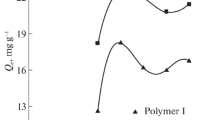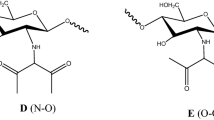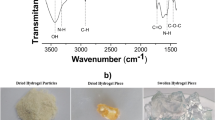Abstract
This study proposes, verifies, and refines the use of biopolymers treated with two new ionic liquids (ILs) (sec-butylammonium acetate and n-octylammonium acetate), as a platform for chromium adsorption. The ILs were synthesized, characterized, and applied to chitosan treatment. Analyzing the size distribution of microparticles of chitosan and chitosan activated with ILs (sec-butylammonium acetate and n-octylammonium acetate), we observed that a little decrease in the particle size occurred with the activation of chitosan (176 ± 0.02 μm to 167 ± 0.054 and 168.5 ± 0.05 μm, respectively), as well as changes in the X-ray diffraction FTIR_ATR spectra. Further studies were performed using the best adsorbent – chitosan treated with sec-butylammonium acetate. In this case, the chromium VI concentration in the sample was reduced by more than 99% when using chitosan treated with IL sec-butylammonium acetate. The best reaction time was determined as 1 h, which allowed a chromium adsorption of 99.1% and the adsorption kinetic data were best represented by the second-order model (k2 = 11.7258 g mg−1 min−1). The maximum adsorption capacity was obtained using the Langmuir isotherm model (20.833 mg g−1 at pH 4 during 1 h, using 1.0 g of chitosan), and the adsorption efficiency was enhanced at 25 °C by the Freundlich isotherm model, in which the constants KF and n were determined as 0.875 mg L−1 and 1.610, respectively.








Similar content being viewed by others
References
Andrade Neto JC, Cabral AS, Oliveira LRD, Torres RB, Morandim-Giannetti AA (2016) Synthesis and characterization of new low-cost ILs based on butylammonium cation and application to lignocellulose hydrolysis. Carbohydr Polym 143:279–287
Borsagli FGLM, Mansur AAP, Chagas P, Oliveira LCA, Mansur HS (2015) O-carboxymethyl functionalization of chitosan, complexation and adsorption of Cd (II) and Cr(VI) as heavy metal pollutant ions. React Funct Polym 97:37–47
Dyson PJ, Ellis DJ, Welton T, Parker DG (1999) Arene hydrogenation in a room-temperature ionic liquid using a ruthenium cluster catalyst. Chem Commun 1:25–26
Fan HL, Li L, Zhou SF, Liu YZ (2016) Continuous preparation of Fe3O4 nanoparticles combined with surface modification by l-cysteine and their application in heavy metal adsorption. Ceram Int 42:4228–4237
Gomes CS, Piccin JS, Gutterres M (2016) Optimizing adsorption parameters in tannery-dye-containing effluent treatment with leather shaving waste. Process Saf Environ Prot 99:98–106
Gore CT, Omwoma S, Chen W, Song YF (2016). Interweaved LDH/PAN nanocomposite films: Application in the design of effective hexavalent chromium adsorption technology. Chem Eng J 284:794–801
Gupta VK, Nayak A (2012) Cadmium removal and recovery from aqueous solutions by novel adsorbents prepared from orange peel and Fe2O3 nanoparticles. Chem Eng J 180:81–90
Gupta VK, Saleh TA (2013) Sorption of pollutants by porous carbon, carbon nanotubes and fullerene–an overview. Environ Sci Pollut Res 20:2828–2843
Gupta VK, Srivastava SK, Mohan D, Sharma S (1997) Design parameters for fixed bed reactors of activated carbon developed from fertilizer waste for the removal of some heavy metal ions. Waste Manag 17:517–522
Gupta VK, Jain R, Nayak A, Agarwal S, Shrivastava M (2011a) Removal of the hazardous dye-tartrazine by photodegradation on titanium dioxide surface. Mater Sci Eng, C 31:1062–1067
Gupta VK, Agarwal S, Saleh TA (2011b) Synthesis and characterization of alumina-coated carbon nanotubes and their application for lead removal. J Hazard Mater 185:17–23
Gupta VK, Ali I, Saleh TA, Nayak A, Agarwal S (2012a) Chemical treatment technologies for waste-water recycling-an overview. RSC Adv 2:6380–6388
Gupta VK, Jain R, Mittal A, Saleh TA, Nayak A, Agarwal S, Sikarwar S (2012b) Photo-catalytic degradation of toxic dye amaranth on TiO2/UV in aqueous suspensions. Mater Sci Eng C 32:12–17
Gupta VK, Mittal A, Jhare D, Mittal J (2012c) Batch and bulk removal of hazardous colouring agent Rose Bengal by adsorption techniques using bottom ash as adsorbent. RSC Adv 2:8381–8389
Gupta VK, Kumar K, Nayak A, Saleh TA, Barakat MA (2013) Adsorptive removal of dyes from aqueous solution onto carbon nanotubes: a review. Adv Colloid Interface Sci 193–194:24–34
Gupta VK, Nayak A, Agarwal S (2015) Bioadsorbents for remediation of heavy metals: current status and their future prospects. Environ Eng Res 20:1–18
He J, Bardelli F, Gehin A, Silvester E, Charlet L (2016) Novel chitosan goethite bionanocomposite beads for arsenic remediation. Water Res 101:1–9
Jeon C, Holl WH (2003) Chemical modification of chitosan and equilibrium study for mercury ion removal. Water Res 37:4770–4780
Jia X, Gong D, Xu B, Chi Q, Zhang X (2016) Development of a novel, fast, sensitive method for chromium speciation in wastewater based on an organic polymer as solid phase extraction material combined with HPLC–ICP-MS. Talanta 147:155–161
Kahu SS, Shekhawat A, Saravanan D, Jugade RM (2016) Two fold modified chitosan for enhanced adsorption of hexavalent chromium from simulated wastewater and industrial effluents. Carbohydr Polym 146:264–273
Karthikeyan S, Gupta VK, Boopathy R, Titus A, Sekaran G (2012) A new approach for the degradation of high concentration of aromatic amine by heterocatalytic Fenton oxidation: kinetic and spectroscopic studies. J Mol Liq 173:153–163
Kumar ASK, Gupta T, Kakan SS, Kalidhasana S, Rajesh V, Rajesh N (2012) Effective adsorption of hexavalent chromium through a three center (3c) co-operative interaction with an ionic liquid and biopolymer. J Hazard Mater 239–240:213–224
Li L, Li Y, Cao L, Yang C (2015) Enhanced chromium (VI) adsorption using nanosized chitosan fibers tailored by electrospinning. Carbohydr Polym 125:206–213
Luo X, Zhang Z, Zhou P, Liu Y, Ma G, Lei Z (2015) Synergic adsorption of acid blue 80 and heavy metal ions (Cu2+/Ni2+) onto activated carbon and its mechanisms. J Ind Eng Chem 27:164–174
Ma X, Liu X, Anderson DP, Chang PR (2015) Modification of porous starch for the adsorption of heavy metal ions from aqueous solution. Food Chem 181:133–139
Malekia A, Hayati B, Naghizadeh M, Joo SW (2015) Adsorption of hexavalent chromium by metal organic frameworks from aqueous solution. J Ind Eng Chem 28:211–216
Matouq M, Jildeh N, Qtaishat M, Hindiyeh M, Al Syouf MQ (2015) The adsorption kinetics and modeling for heavy metals removal from wastewater by Moringa pods. J Environ Chem Eng 3:775–784
Mittal A, Mittal J, Malviya A, Gupta VK (2009a) Adsorptive removal of hazardous anionic dye ‘‘Congo red” from wastewater using waste materials and recovery by desorption. J Colloid Interface Sci 340(2009):16–26
Mittal A, Kaur D, Malviya A, Mittal J, Gupta VK (2009b) Adsorption studies on the removal of coloring agent phenol red from wastewater using waste materials as adsorbents. J Colloid Interface Sci 337:345–354
Mittal A, Mittal J, Malviya A, Kaur D, Gupta VK (2010a) Decoloration treatment of a hazardous triarylmethane dye, Light Green SF (Yellowish) by waste material adsorbents. J Colloid Interface Sci 342:518–527
Mittal A, Mittal J, Malviya A, Gupta VK (2010b) Removal and recovery of Chrysoidine Y from aqueous solutions by waste materials. J Colloid Interface Sci 344:497–507
Pavia DL, Lampman GM, Kriz GS, Vyvyan JR (2015) Introduction to spectroscopy, 5th edn. Cengage Learning, Washington
Polowczyk I, Urbano BF, Rivas BL, Bryjak M, Kabay N (2016) Equilibrium and kinetic study of chromium sorption on resins with quaternary ammonium and N-methyl-D-glucamine groups. Chem Eng J 284:395–404
Saleh TA, Gupta VK (2012a) Photo-catalyzed degradation of hazardous dye methyl orange by use of a composite catalyst consisting of multi-walled carbon nanotubes and titanium dioxide. J Colloid Interface Sci 371:101–106
Saleh TA, Gupta VK (2012b) Column with CNT/magnesium oxide composite for lead (II) removal from water. Environ Sci Pollut Res 19:1224–1228
Saleh TA, Gupta VK (2014) Processing methods, characteristics and adsorption behavior of tires derived carbons: a review. Adv Colloid Interface Sci 211:93–101
Sargın I, Kaya M, Arslan G, Baran T, Ceter T (2012) Preparation and characterisation of biodegradable pollen–chitosan microcapsules and its application in heavy metal removal. Bioresour Technol 177:1–7
Shekhawat A, Kahu S, Saravanan D, Jugade R (2015) Synergistic behaviour of ionic liquid impregnated sulphate-crosslinked chitosan towards adsorption of Cr(VI). Int J Biol Macromol 80:615–626
Shinde RN, Pandey AK, Acharya R, Guin R, Das SK, Rajurkar NS, Pujari PK (2013) Chitosan-transition metal ions complexes for selective arsenic(V) preconcentration. Water Res 47:3497–3506
Silverstein RM, Webster F, Kiemle D (2005) Spectrometric identification of organic compounds, 7th edn. Wiley, New York
Tan C, Zeyu Z, Sai X, Hongtao W, Wenjing L (2015) Adsorption behavior comparison of trivalent and hexavalent chromium on biochar derived from municipal sludge. Bioresour Technol 190:388–394
Wu Y, Fan Y, Zhang M, Ming Z, Yang S, Arkin A, Fang P (2016) Functionalized agricultural biomass as a low-cost adsorbent, utilization of rice straw incorporated with amine groups for the adsorption of Cr(VI) and Ni(II) from single and binary systems. Bio Chem Eng J 105:27–35
Xiang B, Fan W, Yi X, Wang Z, Gao F, Li Y, Gu H (2016) Dithiocarbamate-modified starch derivatives with high heavy metaladsorption performance. Carbohydr Polym 136:30–37
Xiao Q, Sun Y, Zhang J, Li Q (2015) Size-dependent of chromium (VI) adsorption on nano α-Fe2O3 surface. Appl Surf Sci 356:18–23
Xiao K, Xu F, Jiang L, Duan N, Zheng S (2016) Resin oxidization phenomenon and its influence factor during chromium (VI) removal from wastewater using gel-type anion exchangers. Chem Eng J 283:1349–1356
Yang R, Li H, Huang M, Yang H, Li A (2016) A review on chitosan-based flocculants and their applications in water treatment. Water Res 95:59–89
Yue ZB, Li Q, Li C, Chen TH, Wang J (2015) Component analysis and heavy metal adsorption ability of extracellular polymeric substances (EPS) from sulfate reducing bacteria. Bioresour Technol 194:399–402
Zeng L, Chen Y, Zhang Q, Guo X, Peng Y, Xiao H, Chen X, Luo J (2015) Adsorption of Cd(II), Cu(II) and Ni(II) ions by cross-linking chitosan/rectorite nano-hybrid composite microspheres. Carbohydr Polym 130:333–343
Zhou J, Wang Y, Wang J, Qiao W, Long D, Ling L (2016) Effective removal of hexavalent chromium from aqueous solutions by adsorption on mesoporous carbon microspheres. J Colloid Interface Sci 462:200–207
Acknowledgments
We are grateful to Fundação Educacional Inaciana Padre Sabóia de Medeiros (FEI) for supporting this research. We thank Dr. Nivaldo Boralle for the NMR measurements.
Author information
Authors and Affiliations
Corresponding author
Electronic supplementary material
Below is the link to the electronic supplementary material.
Rights and permissions
About this article
Cite this article
Eliodorio, K.P., Andolfatto, V.S., Martins, M.R.G. et al. Treatment of chromium effluent by adsorption on chitosan activated with ionic liquids. Cellulose 24, 2559–2570 (2017). https://doi.org/10.1007/s10570-017-1264-3
Received:
Accepted:
Published:
Issue Date:
DOI: https://doi.org/10.1007/s10570-017-1264-3




